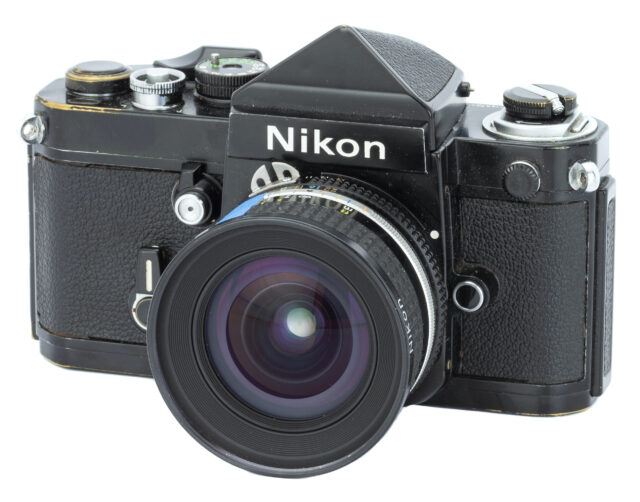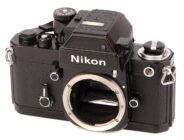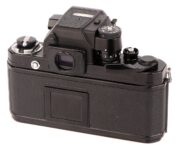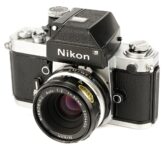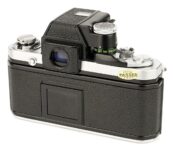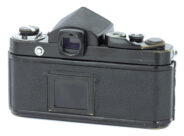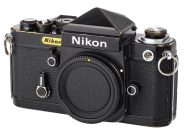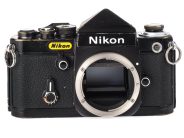Announced
System
Nikon F system cameras
- Nikkorex F
- Nikkormat EL
- Nikkormat ELW
- Nikkormat FS
- Nikkormat FT
- Nikkormat FT2
- Nikkormat FT3
- Nikkormat FTN
- Nikon D3
- Nikon D3s
- Nikon D3X
- Nikon D4
- Nikon D4s
- Nikon D5
- Nikon D6
- Nikon D600
- Nikon D610
- Nikon D700
- Nikon D750
- Nikon D780
- Nikon D800
- Nikon D800E
- Nikon D810
- Nikon D850
- Nikon Df
- Nikon EL2
- Nikon EM
- Nikon F
- Nikon F100
- Nikon F2
- Nikon F3
- Nikon F4
- Nikon F5
- Nikon F6
- Nikon FA
- Nikon FE
- Nikon FE10
- Nikon FE2
- Nikon FG
- Nikon FG-20
- Nikon FM
- Nikon FM10
- Nikon FM2
- Nikon FM2/T
- Nikon FM3A
- Nikon N2000
- Nikon N2020
- Nikon N4004
- Nikon N4004S
- Nikon N50
- Nikon N5005
- Nikon N55
- Nikon N60
- Nikon N6000
- Nikon N6006
- Nikon N65
- Nikon N70
- Nikon N75
- Nikon N80
- Nikon N8008
- Nikon N8008S
- Nikon N90
- Nikon N90S
Nikon F2
35mm MF film SLR camera
Specification
| Format: | |
| 35mm full frame | |
Film type: | 135 cartridge-loaded film |
| Nikon F [46.5mm] | |
| Shutter: | |
Type: | Focal-plane |
Model: | Mechanical |
Speeds: | 10 - 1/2000 + B |
| Exposure: | |
Exposure metering: | None |
Exposure modes: | Manual |
| Physical characteristics: | |
Weight: | 730g |
Dimensions: | 152.5x98x65mm |
Manufacturer description #1
Nikon F2 • F2A & F2AS Photomic are the most advanced, most versatile of all Nikon cameras - indeed, of all 35mm cameras. Differing only in their respective pentaprism finders and meter/finders, they offer ready interchangeability of all components: viewfinders (including Photomic meter/finders), finder screens, motor drives, and camera backs, in addition to all lenses and countless accessories from the Nikon system.
The Nikon F2 is more than the finest of all 35mm cameras; it is the foundation of the entire Nikon System of 35mm photography - the world's largest. Through its uniquely modular concept and construction, it not only challenges but successfully defies obsolescence, permitting interchangeability of all basic components:
- Interchangeable Nikkor and AI-Nikkor Lenses... more than 55 available, from 6mm to 2000mm.
- Interchangeable Viewfinders... including Standard Prism; Photomic through-the-Iens meter/finders,with expanded sensitivity and automatic-exposure capability; Action Prism Finder; Waist-Level Finder, and 6X Focusing Finder.
- Interchangeable Finder Screens... 21 precision screens for every need.
- Interchangeable Nikon Motor Drive System... giving up to 5 exposures per second, requiring no modification, not even removal of camera back.
- Interchangeable Backs... including 250- and 750-Exposure Magazines plus Speed Magny Attachments for Polaroid® and other large-format films.
- Hundreds of Nikon accessories for every requirement.
Through this ingenious, modular design, the Nikon photographer can, in effect, create an infinite number of picture-taking instruments attuned precisely to his specific needs-today and tomorrow.
There are three basic types of Nikon F2 camera/ finder combinations:
- Nikon F2 with Pentaprism Finder DE-1, first choice of photographers employing separate exposure meters.
- Nikon F2 Photomic and F2SB Photomic, supplied with Photomic meter/finders DP-1 and DP-3, respectively, these offer full-aperture, center-weighted metering with all Nikkor lenses with meter-coupling shoe, including all AI-Nikkor lenses; the maximum aperture of the selected lens is indexed with a quick turn of the aperture ring.
- Nikon F2A Photomic and F2AS Photomic, supplied with Photomic DP-11 and DP-12 meter/ finders (respectively), provide center-weighted, full-aperture exposure control, automatic aperture indexing (AI), and through-the-finder Aperture Direct Reading (ADR) with all AI-Nikkor lenses. These most advanced F2 models also permit stop-down metering with non-AI lenses and, like other F2 models, accept all Nikkor SLR lenses from 6mm to 2000mm.
Significantly, any Nikon F2 camera can be converted to any other F2 model by simply substituting the appropriate finder - an example of true modular versatility unrivalled in all photography.
Ultimate Precision and Versatility
Nucleus of the Nikon system, the Nikon F2 camera permits the photographer to choose the lens, viewfinder, finder screen, film magazine, even film transport and exposure control system appropriate to any assignment. Its fast-handling, responsive controls simplify every aspect of the picture-taking process. Each of its 1506 individual parts is engineered to quality standards that have made the name Nikon a universal symbol of optical and mechanical excellence.
Interchangeable Pentaprism Viewfinder
The DE-1 eye-level pentaprism finder supplied with the standard Nikon F2 is silver-coated for maximum brightness and contrast. It gives an upright, laterally-correct image at eye-level and incorporates a built-in ready light for connection with Nikon electronic flash units. Weighing only 3.2 ounces, this compact viewfinder is interchangeable with all other Nikon F2 cameras and accepts all Nikon Eyepiece Correction Lenses and other Nikon eyepiece attachments. Virtually 100% of the film image appears within any F2 viewfinder, for the most accurate image control of any 35mm SLR camera.
Titanium-Foil Focal-Plane Shutter
Exceptionally accurate, resistant to heat and humidity, the Titanium-foil, horizontal-travel shutter is specially "quilted" for extra strength. Basic shutter speed range is 1 second-1/2000th second plus "B", with stepless, continuously variable speed selection from 1/80th second to 1/2000th. Additional shutter speeds of 2, 4, 6, 8, and 10 seconds (or any intermediate interval) are obtained via the built-in self timer. The shutter movement is ball-bearing mounted for ultimate accuracy and repeatability. Shutter curtains "scan" the film plane in just 10 milliseconds. The shutter is built to take the action of motor drive at up to 5 fps.
Oversize Instant-Return Mirror
Enlarged mirror eliminates finder image cut-off even with long telephoto lenses. Sophisticated damping mechanism virtually eliminates impact shock. Mirror may be locked up for special applications. Entire mirror chamber is effectively baffled and finished in matte material to prevent internal reflections.
Automatic Flash-Synch Adjustment
Setting shutter speed automatically adjusts for flash type in use. Electronic flash synch at all speeds to 1/80th second; FP synch from "B" and 1 to 1/30th and 1/125 to 1/2000th second. Special hot shoe provides cordless synch with Nikon-System flash units; automatic safety switch in shoe prevents electrical shock when unit is not in place. Single PC outlet accepts either Nikon screw-in or conventional PC cords.
Interchangeable Finder Screens
Standard Nikon Type K screen incorporates central split-image range-finder with microprism circle and overall matte/Fresnel groundglass for edge-to-edge brightness. Interchangeable with 20 optional Nikon screens.
Short-Stroke Transport Lever
Large, plastic-tipped lever requires only 120 deg. stroke, or any equivalent number of shorter strokes, to advance film, wind shutter, and count exposure. Lever pivots on ball bearings for smoothest operation. Integral locking device prevents accidental shutter release before transport lever has completed its cycle.
Accurately-Registered Multiple Exposures
Simply by depressing the rewind button, then operating the film transport lever, the shutter may be recocked, producing multiple exposures in precise registration. As many exposures as desired may be made on a single frame.
Multi-Function Self-Timer
Calibrated for delays of 2, 4, 6, 8, and 10 seconds. Alternativeiy, with shutter set at "B" and shutter release fingerguard turned to "T", the self-timer produces accurate slow shutter speeds of these durations, or any intermediate times.
Easy Film Loading
The hinged back and multi-slotted take-up spool aid fast, error-free loading. Exposure counter automatically resets to "0" when camera back is opened. Rapid-rewind crank rises 6mm above camera top for unobstructed operation. A Film Memo Holder on the camera back accepts the film carton end tab for a practical reminder of film in use. A unique safety lock makes inadvertent back opening virtually impossible.
Superior Film Flatness
Film winds onto take-up spool emulsion-side-out for greatest tension. The large pressure plate, polished guide rails, and cassette stabilizer combine to assure exceptional film flatness for edge-to-edge sharpness.
Other Features
The fingerguard (around shutter release button) locks/unlocks shutter release, permits time exposures in the absence of a locking cable release, and also allows accurately-timed exposures of 2, 4, 6, 8, and 10 seconds (in conjunction with the self timer) according to the position selected. Depth-of-field preview is provided for focus check (or stop-down exposure measurement with Photomic meter/finder). Neckstrap eyelets are reinforced with stainless steel, and the camera lensmount is made of stainless steel for maximum durability and strength. The Nikon F2 camera accepts all Nikkor and AI-Nikkor lenses from 6mm to 2000mm. It is supplied in satin chrome (Product No. 1600) or professional black finish (Product No. 1605).
Manufacturer description #2
CAMERA TYPE: 35mm SLR with interchangeable lenses, viewfinders, finder screens, film magazines and backs, and motor drives.
LENSMOUNT: Stainless-steel Nikon bayonet accepts all Nikkor lenses 6mm-2000mm and all Nikon-mount accessories. Flange/film distance: 46.5mm. Automatic diaphragm coupling.
EXPOSURE CONTROL: Accepts optional Nikon Photomic meter/finder for through-the-Iens metering.
SHUTTER: Titanium foil, horizontal-travel focal plane; speeds B, 1, 1/2, 1/4, 1/8, 1/15, 1/30, 1/60, 1/80, 1/125, 1/250, 1/500, 1/1000, 1/2000th second via shutter speed dial and 2, 4, 6, 8, and 10 seconds at 'B' position, via self-timer. Speeds continuously variable from 2-10 seconds and 1/80-1/2000th second.
FLASH SYNCHRONIZATION: "X" synch at "B" to 1/80th second; "FP" synch at B, 1-1/30th, and 1/125-1/2000th second; automatic synch adjustment as shutter speed is set.
FLASH CONTACTS: Built-in Nikon F2 hot shoe with automatic safety switch; single PC outlet accepting Nikon screw-in or conventional PC cords.
VIEWFINDER: Interchangeable eye-level Pentaprism Finder DE-1 (supplied) with -1.0 diopter eyepiece and built-in ready light for Nikon electronic flash units. Virtually 100% finder coverage.
FOCUSING SCREEN: Nikon Type K Screen (supplied) with 3mm-diameter split-image rangefinder, 1mm microprism circle plus overall matte/Fresnel area, interchangeable with 20 other Nikon screens.
REFLEX MIRROR: Oversize instant-return type with independent locking control.
FILM LOADING: Multi-slotted take-up spool, hinged back and additive automatic-reset exposure counter for fast loading.
FILM TRANSPORT: Ratchet-action lever advances film, winds shutter, and counts exposures in 120 deg. action, may be left at "ready" position 20 deg. from camera body or folded flush for storage.
FILM REWIND: Rewind-release button on camera baseplate; fold-out rewind crank may be elevated up to 6mm for convenient access.
MULTIPLE EXPOSURE CONTROL: By depressing rewind button while operating transport lever, also operates with Nikon Motor Drive attached.
BATTERY TYPE: None required, camera accepts two 1.5v silver oxide batteries (Eveready S76 or equivalent) to power flash ready light or optional meter/finder.
OTHER FEATURES: Depth-of-field preview; stainless steel reinforced neckstrap eyelets; built-in self timer with calibrated delays of 2, 4, 6, 8, and 10 seconds, also provides slow shutter speeds; fingerguard around shutter release button adjustable to lock or unlock shutter, permits time exposures 2-10 seconds with self timer; film memo holder on camera back stores film carton end tab or other data.
From the editor
The following versions of the Nikon F2 were offered:
- Nikon F2 (1971) - a standard model with conventional DE-1 pentaprism eye-level finder;
- Nikon F2 Photomic (1971) - as F2, but with interchangeable DP-1 Photomic eye-level finder with built-in TTL CdS exposure meter with center-weighted metering. Shutter speed, aperture, and meter needle displayed in the finder;
- Nikon F2 Photomic S (1973) - as F2, but with interchangeable DP-2 Photomic eye-level finder with built-in TTL CdS exposure meter with center-weighted metering. Exposure information displayed with two LEDs;
- Nikon F2 Photomic SB (1976) - as F2, but with interchangeable DP-3 Photomic eye-level finder with built-in TTL SPD exposure meter with center-weighted metering and eyepiece shutter. Exposure information displayed with three LEDs;
- Nikon F2 Photomic A (1977) - as F2, but with interchangeable DP-11 Photomic eye-level finder, the AI version of the DP-1;
- Nikon F2 Photomic AS (1977) - as F2, but with interchangeable DP-12 Photomic eye-level finder, the AI version of the DP-3.
Special editions (1)
- Nikon F2 Titan - 1979
Similar cameras (4)
35mm full frame • Manual focus • Film • Singe-lens reflex • Nikon F mount
| Model | Shutter | Metering | Modes | Year |
|---|---|---|---|---|
| Kiev-17 aka Киев-17 |
M, 1/1000 | -- | M | 1978 |
| Kiev-19 aka Киев-19 |
M, 1/500 | TTL • WA | M | 1985 |
| Kiev-19M aka Киев-19М |
M, 1/500 | TTL • OA | M | 1988 |
| Kiev-20 aka Киев-20 |
M, 1/1000 | TTL • OA | M | 1983 |
